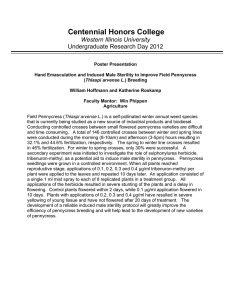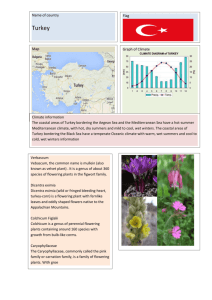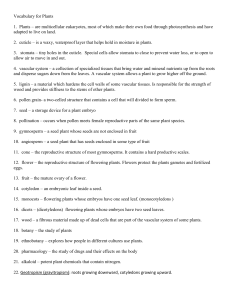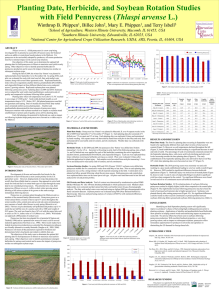Determining the Role of Day Length and Temperature on Thlaspi arvense
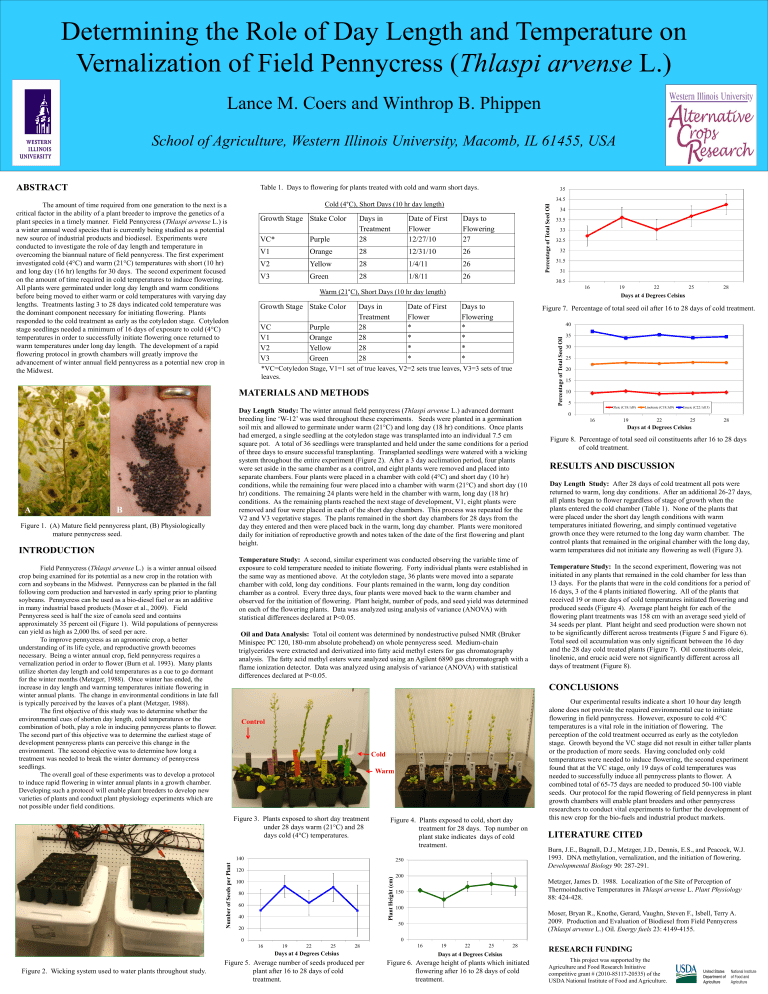
Determining the Role of Day Length and Temperature on
Vernalization of Field Pennycress ( Thlaspi arvense L.)
Lance M. Coers and Winthrop B. Phippen
School of Agriculture, Western Illinois University, Macomb, IL 61455, USA
ABSTRACT
The amount of time required from one generation to the next is a critical factor in the ability of a plant breeder to improve the genetics of a plant species in a timely manner. Field Pennycress (
Thlaspi arvense
L.) is a winter annual weed species that is currently being studied as a potential new source of industrial products and biodiesel. Experiments were conducted to investigate the role of day length and temperature in overcoming the biannual nature of field pennycress. The first experiment investigated cold (4°C) and warm (21°C) temperatures with short (10 hr) and long day (16 hr) lengths for 30 days. The second experiment focused on the amount of time required in cold temperatures to induce flowering.
All plants were germinated under long day length and warm conditions before being moved to either warm or cold temperatures with varying day lengths. Treatments lasting 3 to 28 days indicated cold temperature was the dominant component necessary for initiating flowering. Plants responded to the cold treatment as early as the cotyledon stage. Cotyledon stage seedlings needed a minimum of 16 days of exposure to cold (4°C) temperatures in order to successfully initiate flowering once returned to warm temperatures under long day length. The development of a rapid flowering protocol in growth chambers will greatly improve the advancement of winter annual field pennycress as a potential new crop in the Midwest.
A B
Figure 1. (A) Mature field pennycress plant, (B) Physiologically
mature pennycress seed.
INTRODUCTION
Field Pennycress (
Thlaspi arvense
L.) is a winter annual oilseed crop being examined for its potential as a new crop in the rotation with corn and soybeans in the Midwest. Pennycress can be planted in the fall following corn production and harvested in early spring prior to planting soybeans. Pennycress can be used as a bio-diesel fuel or as an additive in many industrial based products (Moser et al., 2009). Field
Pennycress seed is half the size of canola seed and contains approximately 35 percent oil (Figure 1). Wild populations of pennycress can yield as high as 2,000 lbs. of seed per acre.
To improve pennycress as an agronomic crop, a better understanding of its life cycle, and reproductive growth becomes necessary. Being a winter annual crop, field pennycress requires a vernalization period in order to flower (Burn et al. 1993). Many plants utilize shorten day length and cold temperatures as a cue to go dormant for the winter months (Metzger, 1988). Once winter has ended, the increase in day length and warming temperatures initiate flowering in winter annual plants. The change in environmental conditions in late fall is typically perceived by the leaves of a plant (Metzger, 1988).
The first objective of this study was to determine whether the environmental cues of shorten day length, cold temperatures or the combination of both, play a role in inducing pennycress plants to flower.
The second part of this objective was to determine the earliest stage of development pennycress plants can perceive this change in the environment. The second objective was to determine how long a treatment was needed to break the winter dormancy of pennycress seedlings.
The overall goal of these experiments was to develop a protocol to induce rapid flowering in winter annual plants in a growth chamber.
Developing such a protocol will enable plant breeders to develop new varieties of plants and conduct plant physiology experiments which are not possible under field conditions.
Table 1. Days to flowering for plants treated with cold and warm short days.
Cold (4
°
C), Short Days (10 hr day length)
Growth Stage Stake Color Days in
VC* Purple
Treatment
28
V1 Orange 28
V2
V3
Yellow
Green
28
28
Date of First
Flower
12/27/10
12/31/10
1/4/11
1/8/11
Warm (21
°
C), Short Days (10 hr day length)
Days to
Flowering
27
26
26
26
Growth Stage Stake Color Days in
Treatment
VC
V1
Purple
Orange
28
28
V2
V3
Yellow
Green
28
28
Date of First
Flower
*
*
*
*
Days to
Flowering
*
*
*
*
*VC=Cotyledon Stage, V1=1 set of true leaves, V2=2 sets true leaves, V3=3 sets of true leaves.
MATERIALS AND METHODS
Day Length Study:
The winter annual field pennycress (
Thlaspi arvense
L.) advanced dormant breeding line ‘W-12’ was used throughout these experiments. Seeds were planted in a germination soil mix and allowed to germinate under warm (21°C) and long day (18 hr) conditions. Once plants had emerged, a single seedling at the cotyledon stage was transplanted into an individual 7.5 cm square pot. A total of 36 seedlings were transplanted and held under the same conditions for a period of three days to ensure successful transplanting. Transplanted seedlings were watered with a wicking system throughout the entire experiment (Figure 2). After a 3 day acclimation period, four plants were set aside in the same chamber as a control, and eight plants were removed and placed into separate chambers. Four plants were placed in a chamber with cold (4°C) and short day (10 hr) conditions, while the remaining four were placed into a chamber with warm (21°C) and short day (10 hr) conditions. The remaining 24 plants were held in the chamber with warm, long day (18 hr) conditions. As the remaining plants reached the next stage of development, V1, eight plants were removed and four were placed in each of the short day chambers. This process was repeated for the
V2 and V3 vegetative stages. The plants remained in the short day chambers for 28 days from the day they entered and then were placed back in the warm, long day chamber. Plants were monitored daily for initiation of reproductive growth and notes taken of the date of the first flowering and plant height.
Temperature Study:
A second, similar experiment was conducted observing the variable time of exposure to cold temperature needed to initiate flowering. Forty individual plants were established in the same way as mentioned above. At the cotyledon stage, 36 plants were moved into a separate chamber with cold, long day conditions. Four plants remained in the warm, long day condition chamber as a control. Every three days, four plants were moved back to the warm chamber and observed for the initiation of flowering. Plant height, number of pods, and seed yield was determined on each of the flowering plants. Data was analyzed using analysis of variance (ANOVA) with statistical differences declared at P<0.05.
Oil and Data Analysis:
Total oil content was determined by nondestructive pulsed NMR (Bruker
Minispec PC 120, 180-mm absolute probehead) on whole pennycress seed. Medium-chain triglycerides were extracted and derivatized into fatty acid methyl esters for gas chromatography analysis. The fatty acid methyl esters were analyzed using an Agilent 6890 gas chromatograph with a flame ionization detector. Data was analyzed using analysis of variance (ANOVA) with statistical differences declared at P<0.05.
Control
Cold
Warm
Figure 3. Plants exposed to short day treatment
under 28 days warm (21°C) and 28
days cold (4°C) temperatures.
Figure 4. Plants exposed to cold, short day
treatment for 28 days. Top number on
plant stake indicates days of cold
treatment.
Figure 2. Wicking system used to water plants throughout study.
140
120
100
80
60
40
20
0
16 19 22 25
Days at 4 Degrees Celsius
28
Figure 5. Average number of seeds produced per
plant after 16 to 28 days of cold
treatment.
250
200
150
100
50
0
16 19 22 25 28
Days at 4 Degrees Celsius
Figure 6. Average height of plants which initiated
flowering after 16 to 28 days of cold
treatment.
35
34.5
34
33.5
33
32.5
32
31.5
31
30.5
16 19 22
Days at 4 Degrees Celsius
25 28
Figure 7. Percentage of total seed oil after 16 to 28 days of cold treatment.
40
35
30
25
20
15
10
5
Oleic (C18:1d9) Linolenic (C18:3d9) Erucic (C22:1d13)
0
16 19 22 25
Days at 4 Degrees Celsius
28
Figure 8. Percentage of total seed oil constituents after 16 to 28 days
of cold treatment.
RESULTS AND DISCUSSION
Day Length Study:
After 28 days of cold treatment all pots were returned to warm, long day conditions. After an additional 26-27 days, all plants began to flower regardless of stage of growth when the plants entered the cold chamber (Table 1). None of the plants that were placed under the short day length conditions with warm temperatures initiated flowering, and simply continued vegetative growth once they were returned to the long day warm chamber. The control plants that remained in the original chamber with the long day, warm temperatures did not initiate any flowering as well (Figure 3).
Temperature Study:
In the second experiment, flowering was not initiated in any plants that remained in the cold chamber for less than
13 days. For the plants that were in the cold conditions for a period of
16 days, 3 of the 4 plants initiated flowering. All of the plants that received 19 or more days of cold temperatures initiated flowering and produced seeds (Figure 4). Average plant height for each of the flowering plant treatments was 158 cm with an average seed yield of
34 seeds per plant. Plant height and seed production were shown not to be significantly different across treatments (Figure 5 and Figure 6).
Total seed oil accumulation was only significant between the 16 day and the 28 day cold treated plants (Figure 7). Oil constituents oleic, linolenic, and erucic acid were not significantly different across all days of treatment (Figure 8).
CONCLUSIONS
Our experimental results indicate a short 10 hour day length alone does not provide the required environmental cue to initiate flowering in field pennycress. However, exposure to cold 4°C temperatures is a vital role in the initiation of flowering. The perception of the cold treatment occurred as early as the cotyledon stage. Growth beyond the VC stage did not result in either taller plants or the production of more seeds. Having concluded only cold temperatures were needed to induce flowering, the second experiment found that at the VC stage, only 19 days of cold temperatures was needed to successfully induce all pennycress plants to flower. A combined total of 65-75 days are needed to produced 50-100 viable seeds. Our protocol for the rapid flowering of field pennycress in plant growth chambers will enable plant breeders and other pennycress researchers to conduct vital experiments to further the development of this new crop for the bio-fuels and industrial product markets.
LITERATURE CITED
Burn, J.E., Bagnall, D.J., Metzger, J.D., Dennis, E.S., and Peacock, W.J.
1993. DNA methylation, vernalization, and the initiation of flowering.
Developmental Biology
90: 287-291.
Metzger, James D. 1988. Localization of the Site of Perception of
Thermoinductive Temperatures in
Thlaspi arvense
L.
Plant Physiology
88: 424-428.
Moser, Bryan R., Knothe, Gerard, Vaughn, Steven F., Isbell, Terry A.
2009. Production and Evaluation of Biodiesel from Field Pennycress
(
Thlaspi arvense
L.) Oil.
Energy fuels
23: 4149-4155.
RESEARCH FUNDING
This project was supported by the
Agriculture and Food Research Initiative competitive grant # (2010-85117-20535) of the
USDA National Institute of Food and Agriculture.
